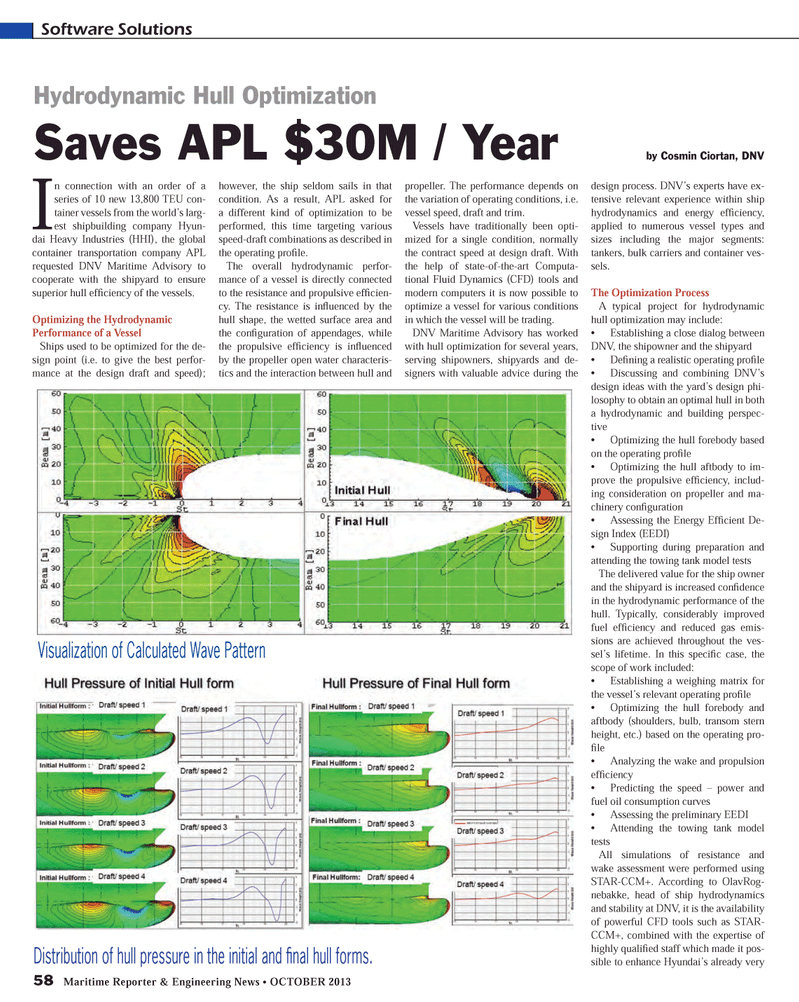
Page 58: of Maritime Reporter Magazine (October 2013)
Marine Design & Construction
Read this page in Pdf, Flash or Html5 edition of October 2013 Maritime Reporter Magazine
58 Maritime Reporter & Engineering News ? OCTOBER 2013 In connection with an order of a series of 10 new 13,800 TEU con- tainer vessels from the world?s larg- est shipbuilding company Hyun-dai Heavy Industries (HHI), the global container transportation company APL requested DNV Maritime Advisory to cooperate with the shipyard to ensure superior hull efÞ ciency of the vessels. Optimizing the Hydrodynamic Performance of a Vessel Ships used to be optimized for the de-sign point (i.e. to give the best perfor-mance at the design draft and speed); however, the ship seldom sails in that condition. As a result, APL asked for a different kind of optimization to be performed, this time targeting various speed-draft combinations as described in the operating proÞ le.The overall hydrodynamic perfor- mance of a vessel is directly connected to the resistance and propulsive efÞ cien-cy. The resistance is in ß uenced by the hull shape, the wetted surface area and the conÞ guration of appendages, while the propulsive efÞ ciency is in ß uenced by the propeller open water characteris-tics and the interaction between hull and propeller. The performance depends on the variation of operating conditions, i.e. vessel speed, draft and trim.Vessels have traditionally been opti- mized for a single condition, normally the contract speed at design draft. With the help of state-of-the-art Computa-tional Fluid Dynamics (CFD) tools and modern computers it is now possible to optimize a vessel for various conditions in which the vessel will be trading.DNV Maritime Advisory has worked with hull optimization for several years, serving shipowners, shipyards and de-signers with valuable advice during the design process. DNV?s experts have ex- tensive relevant experience within ship hydrodynamics and energy ef Þ ciency, applied to numerous vessel types and sizes including the major segments: tankers, bulk carriers and container ves-sels.The Optimization Process A typical project for hydrodynamic hull optimization may include:? Establishing a close dialog between DNV, the shipowner and the shipyard ? DeÞ ning a realistic operating pro Þ le? Discussing and combining DNV?s design ideas with the yard?s design phi- losophy to obtain an optimal hull in both a hydrodynamic and building perspec-tive? Optimizing the hull forebody based on the operating proÞ le? Optimizing the hull aftbody to im- prove the propulsive efÞ ciency, includ- ing consideration on propeller and ma-chinery conÞ guration? Assessing the Energy Ef Þ cient De- sign Index (EEDI)? Supporting during preparation and attending the towing tank model testsThe delivered value for the ship owner and the shipyard is increased conÞ dence in the hydrodynamic performance of the hull. Typically, considerably improved fuel efÞ ciency and reduced gas emis- sions are achieved throughout the ves-sel?s lifetime. In this speci Þ c case, the scope of work included:? Establishing a weighing matrix for the vessel?s relevant operating pro Þ le? Optimizing the hull forebody and aftbody (shoulders, bulb, transom stern height, etc.) based on the operating pro-Þ le? Analyzing the wake and propulsion efÞ ciency? Predicting the speed ? power and fuel oil consumption curves? Assessing the preliminary EEDI ? Attending the towing tank model testsAll simulations of resistance and wake assessment were performed using STAR-CCM+. According to OlavRog- nebakke, head of ship hydrodynamics and stability at DNV, it is the availability of powerful CFD tools such as STAR- CCM+, combined with the expertise of highly qualiÞ ed staff which made it pos- sible to enhance Hyundai?s already very Software SolutionsHydrodynamic Hull Optimization Saves APL $30M / Year by Cosmin Ciortan, DNVDistribution of hull pressure in the initial and Þ nal hull forms. Visualization of Calculated Wave Pattern MR #10 (58-65).indd 58MR #10 (58-65).indd 5810/3/2013 2:13:58 PM10/3/2013 2:13:58 PM

 57
57

 59
59
